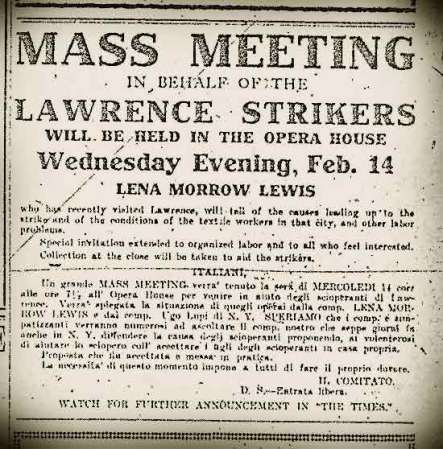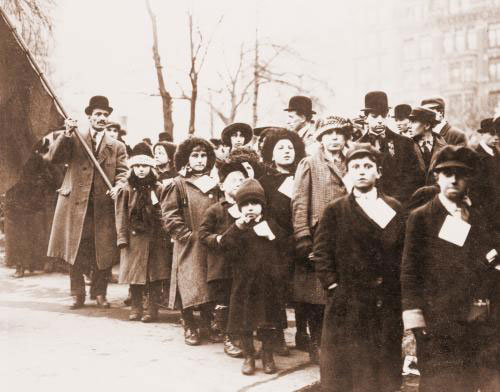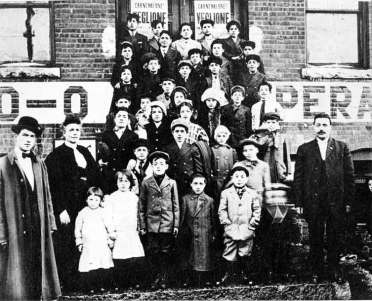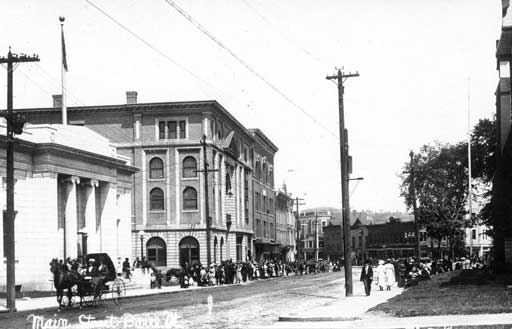Barre Supports the Strike
 News of the great Lawrence strike soon spread to Barre. Many Barre people were members of the Industrial Workers of the World which played an important part in organizing the strikers and finding help for them from other parts of the country. By February 8th of 1912 there had been a community-wide meeting at the Socialist Labor Party Hall on Granite Street attended by more than 350 citizens who pledged their unanimous support for the Lawrence textile workers.
News of the great Lawrence strike soon spread to Barre. Many Barre people were members of the Industrial Workers of the World which played an important part in organizing the strikers and finding help for them from other parts of the country. By February 8th of 1912 there had been a community-wide meeting at the Socialist Labor Party Hall on Granite Street attended by more than 350 citizens who pledged their unanimous support for the Lawrence textile workers.
This was the first of a series of community meetings and events that supported a major fundraising effort which would culminate in the sending of hundreds of dollars to Lawrence to support the strikers, all collected from the working people of Barre. The meetings were conducted in both English and Italian, since the supporters of the Hall were drawn largely from the ranks of Italian immigrant stone cutters.
Their resolution, adopted a week later, read in part, “We in mass meeting tender the workers of Lawrence our heartfelt sympathy in the sad condition capital has placed them in, and pledge them our moral and financial assistance in the heroic struggle they are making for mere existence.” The Barre Times reported a subsequent “meeting held in the Socialist hall on Granite Street appointed Antonio Broggi and Tibaldo Rossi to represent the Barre sympathizers at Lawrence in an effort to allow some of the strikers’ children to come to this city for a time.”
 After a month of increasing tensions and escalating violence, including the death of Anna LoPizzo, a worker from Italy, many strikers sent their children to safety.
After a month of increasing tensions and escalating violence, including the death of Anna LoPizzo, a worker from Italy, many strikers sent their children to safety.
Sympathizers in cities ranging from New York and Philadelphia to Barre, Vermont, received the “Children’s Exodus” with public fanfare to demonstrate their solidarity with the Lawrence strikers. “250 workmen gathered in the Socialist hall” on February 15th reported the Barre Times, “to make some of the final arrangements for housing and feeding the children of the strikers.” The account continued, “On the arrival of the Lawrence children tomorrow, it is proposed to have them participate in a parade through the streets. Later they will be taken to the Socialist hall on Granite Street and given a dinner.”
The children were met on February 17th at the train station on Depot Square by a crowd of several hundred citizens and, in a festive procession marched from Depot Square to City Hall Park and then back to Granite Street and the Socialist Labor Party Hall.
The Barre Times reported, “A band made up of musicians from Barre, Bethel and Waterbury furnished music at the station as well as later during the parade to the city hall, around the park and thence back down Main Street to the Socialist hall on Granite Street. Borne aloft by men and women and children were signs with the legend ‘Help the Strikers.’ They were written in both the Italian and English languages and added an interesting touch of color to the scene.
Among those who assembled to greet the youngsters from Lawrence were members of the families who were later to receive a child at the hall on Granite Street. Such persons were designated by ribbons, while members of the committees instrumental in raising much of the money subscribed by local people for the purpose also wore the little streamers of red.”
The large crowd followed the parade and, at the Socialist Hall, physicians were on hand to examine the children as to their physical fitness and immunity from disease. “A monstrous banquet was spread at the hall and the youngsters fell to it with a will after the examination was over.” Then the children were equipped with warm coats.

 After assembling for a photograph on the granite steps of the famous landmark, they were sent home with the families who gave them shelter. One of the children recalled over eighty years later: “I never seen a thing the way they treated us; it was marvelous, marvelous. They brought us to a hall, a stage, then took us one by one and asked if anybody wanted this boy or girl…when it came to me, the guy and wife took me, brought me home, showed me my bedroom, and started figuring out what to buy. They bought me a suit, a sled, some shirts and ties. I don’t remember the name of the family. There was a girl my age. They bought me a sled and we used to go coasting every day. The only thing was we were young. We were wanting our families.”
After assembling for a photograph on the granite steps of the famous landmark, they were sent home with the families who gave them shelter. One of the children recalled over eighty years later: “I never seen a thing the way they treated us; it was marvelous, marvelous. They brought us to a hall, a stage, then took us one by one and asked if anybody wanted this boy or girl…when it came to me, the guy and wife took me, brought me home, showed me my bedroom, and started figuring out what to buy. They bought me a suit, a sled, some shirts and ties. I don’t remember the name of the family. There was a girl my age. They bought me a sled and we used to go coasting every day. The only thing was we were young. We were wanting our families.”
In Barre, there were reports that some of the youngsters were brought to the Granite City without proper parental notification. Two days after their arrival two boys were taken back to the strike-torn mill town after their father complained that they were sent away without his approval.
 Erroneous reports of unhappy children were planted in Boston newspapers and they were denied by delegates from both Barre and Lawrence. It was later revealed that agents of the mill owners had fabricated accounts of mistreated children to cause uncertainty among the strikers and their supporters.
Erroneous reports of unhappy children were planted in Boston newspapers and they were denied by delegates from both Barre and Lawrence. It was later revealed that agents of the mill owners had fabricated accounts of mistreated children to cause uncertainty among the strikers and their supporters.
A written agreement which accompanied the departure of each child from Lawrence stipulated that “the Italian committee promises to properly feed and warmly shelter the children during their stay in Barre and to see that each child of school age is sent to the public schools. It is further guaranteed that none of the children shall be forced to do manual labor of any kind and that their return to Lawrence is subject to the call of the parents. ”
To preclude the possibility of any child being lost, a tag bearing the identity of the wearer is sewed to the young one’s clothing. [See picture of the children marching to the Lawrence train station above left.] Tonight the children will assemble at the Socialist hall on Granite Street, where each will be supplied with a badge on which is written the words, ‘Lawrence boy,’ or ‘Lawrence girl’.”
By mid March eight of the Lawrence children returned home, and by March 30th the last of the 35 were sent home with a large group of Barre sympathizers at the depot to bid them goodbye. Preparations for the send-off were made at the Socialist hall “under the auspices of the Italian strike committee.”
The dispute was settled in mid March on terms that were favorable to the workers and it brought national attention to the plight of immigrant workers and their children in the New England mill towns. And in Barre, there is still pride in the role the Granite City played on behalf of the workers in the textile mills.







